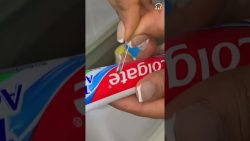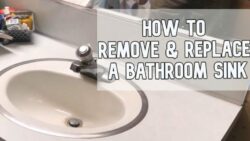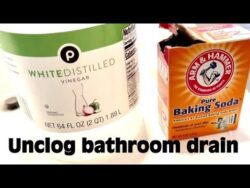When it comes to household plumbing issues, a clogged drain with standing water can be one of the most frustrating and inconvenient problems to tackle. However, fear not, as this article presents a comprehensive guide on the most effective methods to unclog a drain with standing water. By following these step-by-step instructions, you will be equipped with the knowledge and tools needed to successfully resolve this predicament and restore the smooth flow of water in no time.
Inspect the Drain
When dealing with a clogged drain, the first step is to inspect the drain and identify any visible clogs. Take a close look at the drain opening and the surrounding area to see if there are any obvious blockages, such as hair, soap scum, or other debris. Clearing these visible clogs can often solve the problem and restore proper drainage.
Next, check the drain cover, if applicable. Some drains, particularly bathroom drains, have covers that can be easily removed for cleaning. Carefully remove the cover and inspect it for any debris or build-up. If you spot any, clean it thoroughly before reattaching the cover.
Finally, examine the overflow holes, especially in sinks and tubs. These holes are designed to prevent overflowing, but they can also get clogged with debris over time. If the overflow holes appear to be blocked, use a small brush or pipe cleaner to clear them out.
Remove Debris
If the visible clogs haven’t resolved the issue, it’s time to move on to removing debris that may be causing the blockage. There are a few methods you can try to dislodge and clear the debris from the drain.
One effective method is to use a plunger. Ensure there is enough standing water in the sink or tub to cover the suction cup of the plunger. Place the plunger over the drain and firmly press down to create a seal. Then, quickly and vigorously push and pull the plunger to create suction and push the water back and forth, which can help dislodge the clog.
Another option is to try a bent wire hanger. Straighten out the hanger, leaving a small hook at one end. Insert the hook into the drain and gently rotate it to catch onto any debris. Carefully pull up the hanger to remove the clog. Be cautious not to push the debris further down the drain.
Utilizing a drain snake can also be effective in removing debris. Feed the end of the drain snake into the drain until you feel resistance. Rotate the snake handle or crank to break up and grab onto the clog. Slowly pull out the snake, bringing the clog with it. This method can be highly effective for stubborn clogs.
Use Boiling Water
Boiling water can be a simple yet effective method to unclog a drain. Boil a pot of water on the stove or use a kettle to heat water. Once the water reaches a rolling boil, carefully pour it down the drain in a steady stream.
The hot water can help dissolve any grease or soap scum build-up that may be causing the blockage. This method is particularly useful for drains that are clogged due to fatty substances that solidify when cooled.
It’s important to exercise caution when pouring boiling water down the drain. Use a heat-resistant container to hold the boiling water and pour it slowly to avoid splashing or burning yourself.
Try Baking Soda and Vinegar
Baking soda and vinegar can be a powerful combination when it comes to unclogging drains. Start by pouring a cup of baking soda down the drain. Follow this with a cup of vinegar, and immediately cover the drain with a plug or a cloth to trap the reaction.
The chemical reaction between the baking soda and vinegar creates a foaming action that can help break down organic matter and dislodge clogs. Leave the mixture to sit for about 30 minutes, allowing it enough time to work its magic.
After the designated time has passed, remove the cover and run hot water down the drain for a few minutes to flush away any remaining debris. This method is safe for most types of drains and can be repeated if necessary.
Use a Wet/Dry Vacuum
If the clogging persists, using a wet/dry vacuum can be an effective solution. Ensure the vacuum is set to liquid mode before starting. Place the vacuum’s hose directly over the drain, ensuring a tight seal.
To create an airtight seal and prevent any leakage, cover the vent located on the vacuum’s body with a cloth or your hand. This will increase the suction power and help draw out the water and debris.
Turn on the vacuum and allow it to suck out the water and clog the drain. Continue the process until the water has been completely removed. Make sure to empty the vacuum tank once finished.
Use Chemical Drain Cleaners
Chemical drain cleaners can be a quick and convenient solution for resolving drain blockages. When choosing a drain cleaner, select one that is suitable for the type of drain you are working on, such as a sink or a tub.
Carefully read and follow the instructions provided by the manufacturer on the product’s packaging. Always wear protective gloves and goggles when handling chemical drain cleaners. These cleaners work by dissolving or breaking down the clog, allowing it to be flushed away with water.
Make sure to use the drain cleaner sparingly and avoid using it in combination with other cleaning products, as this can result in harmful chemical reactions. After the recommended wait time, flush the drain with hot water to rinse away any remaining residue.
Make a Homemade Drain Cleaner
For those who prefer to use natural and eco-friendly methods, a homemade drain cleaner can be an excellent option. Create a mixture of baking soda and salt, using equal parts of both ingredients.
Carefully pour the homemade drain cleaner down the clogged drain, ensuring it reaches the problematic area. Let the mixture sit for about 30 minutes, allowing it to work on breaking down the clog. Follow this by flushing the drain with hot water to remove any remaining debris.
This homemade solution is safe to use and can be repeated if necessary. It is particularly effective in breaking down organic matter and can be used as a preventive maintenance method.
Try Salt and Hot Water
A simple mixture of salt and hot water can sometimes do wonders in clearing a clogged drain. Heat water, but not to boiling point, and add a handful of salt to it. Stir until the salt dissolves completely.
Slowly pour the salt water mixture down the drain, allowing it to make its way through the clog. The hot water helps dissolve grease and other substances, while the salt acts as a natural scouring agent, helping to break down the clog. Repeat the process a few times if necessary.
Use a Plumber’s Snake
When all else fails, a plumber’s snake, also known as a plumbing auger, can be your best bet to clear a stubborn clog. Insert the snake into the drain, making sure to push it in as far as it will go.
Once inside, turn the handle or crank to engage the snake and start breaking up the clog. Move the snake around, making sure to cover as much of the drain as possible. With each turn, the snake will help break apart the clog, allowing water to flow freely again.
It’s important to be gentle when using a plumber’s snake, especially with delicate or older pipes. Take your time and avoid using excessive force, as you could cause damage to the drain or pipes.
Call a Professional Plumber
If you’ve tried all the DIY methods and the clog stubbornly persists, it may be time to call in the professionals. Local plumbing services have the necessary expertise and tools to tackle even the most challenging drain blockages.
Contact a reputable plumbing service in your area and schedule an appointment for assistance. The professionals will assess the situation, determine the cause of the clog, and provide suitable solutions. Hiring a professional plumber ensures that the problem is resolved safely and efficiently, giving you peace of mind.
In conclusion, dealing with a clogged drain can be a frustrating experience. However, by following these effective methods and taking the necessary precautions, you can successfully unclog your drain and restore proper water flow. Remember to start with the most straightforward methods, such as inspecting for visible clogs and removing debris, before moving on to more advanced techniques. If all else fails, don’t hesitate to seek the help of a professional plumber who will offer their expertise and resolve the issue for you.





